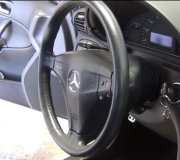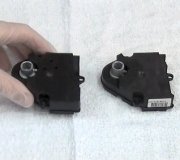SYSTEM OPERATION INTERMITTENT
Preliminary Checks
Ensure engine is properly tuned. If condition occurs while operating control switches or turning steering wheel, check control switches and clockspring assembly. See CONTROL SWITCHES under TESTING. If intermittent condition is not apparently related to control switches or clockspring, check the following:
� Vacuum system for leakage. See VACUUM SYSTEM under TESTING.
� Control switches. See CONTROL SWITCHES under TESTING.
� Servo. See SERVO under TESTING.
� Amplifier. See AMPLIFIER under TESTING.
� Wiring circuits. See AMPLIFIER under TESTING.
AMPLIFIER
NOTE:
Perform tests by backprobing 6-pin amplifier connector (unless specified otherwise). See Fig. 1. See AMPLIFIER LOCATION table under REMOVAL & INSTALLATION. Use only a digital volt-ohmmeter with an input impedance of 10 megohms for making measurements. DO NOT use test light to test any circuit connected to amplifier.
Power Circuit
Turn ignition on. Measure power circuit voltage between White/Purple wire of amplifier connector terminal and ground. Battery voltage should exist. If battery voltage does not exist, check for blown fuse and open wire from fuse panel.
ON Circuit
1. Measure voltage between Pin No. 5 at 6-pin amplifier connector and ground. See Fig. 1. Battery voltage should exist when cruise control ON button is pressed. If battery voltage exists, go to next step. If battery voltage does not exist, perform CONTROL SWITCHES test. If control switches are okay, check Light Blue/Black wire for open or short circuit.
2. Release ON button. Voltmeter should indicate about 7.8 volts. Voltage should remain at 7.8 volts until another cruise control switch is pressed. If no voltage is present, check system ground wiring. Install a known good amplifier, and recheck circuit.
OFF Circuit
Turn ignition on. Measure voltage between Pin No. 5 at 6-pin amplifier connector and ground. Press and hold cruise control OFF button. If voltage does not drop to zero, perform CONTROL SWITCHES test. If voltage drops to zero, switch is okay. Install a known good amplifier, and retest circuit.
VACUUM SYSTEM CHECK
Vacuum Supply
Check vacuum at servo with engine running. Normal servo operation requires at least 2.5 in. Hg vacuum. If vacuum is low, check vacuum hose connections at intake manifold, check valve, servo and dump valve. Also check for pinched or leaking hoses. Go to next step.
Check Valve
Test vacuum check valve by disconnecting hose between check valve and servo. Apply 18 in. Hg vacuum to check valve. If vacuum does not hold, replace check valve. If check valve is okay, go to next step.
Dump Valve
Disconnect dump valve vacuum hose at servo. Connect hand vacuum pump to hose, and apply 18 in. Hg vacuum. If vacuum does not hold, replace or adjust vacuum dump valve. Replace vacuum hoses as necessary. If vacuum holds, press brake pedal with vacuum applied to dump valve. If vacuum releases, dump valve is okay. If vacuum does not release, adjust or replace dump valve.
CONTROL SWITCHES
1. Check cruise control circuit fuse and stoplight fuse. If fuses are okay, unplug 6-pin amplifier connector. Connect voltmeter between Pin No. 5 at 6-pin amplifier connector and ground.
2. Turn ignition on. Press cruise control ON button. Check for battery voltage. If battery voltage does not exist, check circuit between control switch and amplifier connector. Repair circuit as necessary.
3. Turn ignition off. Disconnect negative battery cable. Connect ohmmeter in place of voltmeter. Rotate steering wheel through its full range while performing following checks:
� Press OFF button. Resistance should be 0-1 ohm.
� Press SET/ACCEL button. Resistance should be 646-714 ohms.
� Press COAST button. Resistance should be 114-126 ohms.
� Press RESUME button. Resistance should be 2090-2310 ohms.
If resistances are within specification switches are okay. If resistance is not within specification, perform resistance check at control switch to isolate. If switches check okay, check clockspring assembly, or related wiring circuits for opens or shorts.
Wednesday, December 29th, 2010 AT 2:47 PM


